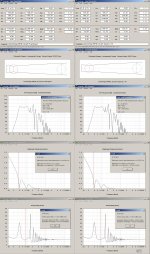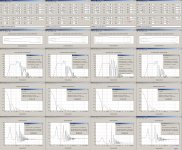Picked up a couple of these on ebay:


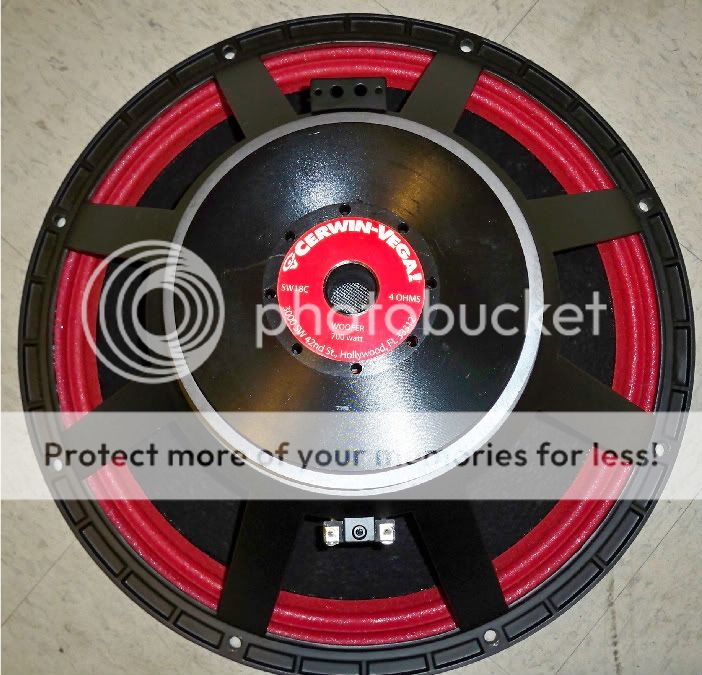
These are the parameters after 3 hrs of playing a 20Hz tone generating about +/- 10mm of excursion and a nice warm backplate:
* This data was exported from the Dayton Audio WT3 Woofer Tester
*
* Manufacturer: Cerwin-Vega!
* Model: SW18C
* Piston Diameter = 387.4 mm
* f(s)= 34.99 Hz
* R(e)= 3.43 Ohms
* Z(max)= 52.13 Ohms
* Q(ms)= 4.919
* Q(es)= 0.347
* Q(ts)= 0.324
* V(as)= 156.400 liters (5.522 cubic feet)
* L(e)= 3.42 mH
* n(0)= 1.84 %
* SPL= 94.75 1W/1m
* M(ms)= 257.90 grams
* C(ms)= 0.08 mm/N
* BL= 23.69
They model nicely in a tapped horn:
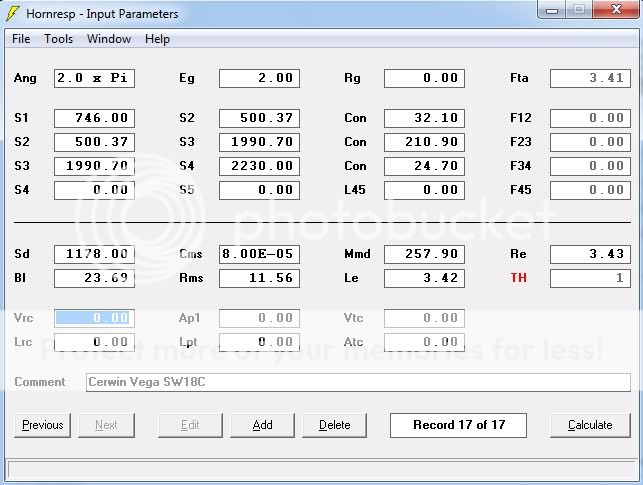
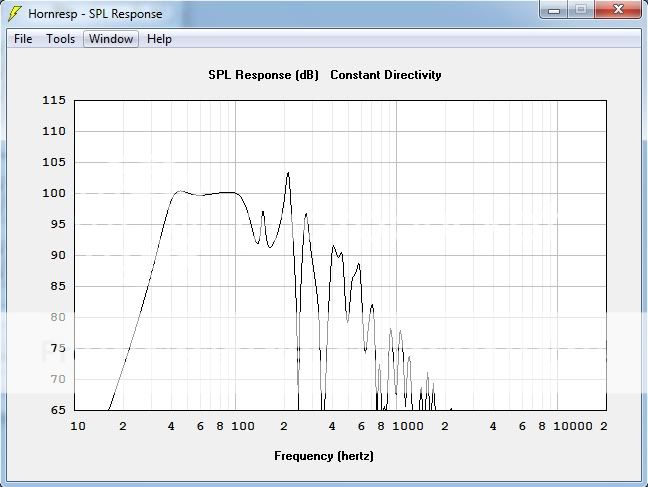



These are the parameters after 3 hrs of playing a 20Hz tone generating about +/- 10mm of excursion and a nice warm backplate:
* This data was exported from the Dayton Audio WT3 Woofer Tester
*
* Manufacturer: Cerwin-Vega!
* Model: SW18C
* Piston Diameter = 387.4 mm
* f(s)= 34.99 Hz
* R(e)= 3.43 Ohms
* Z(max)= 52.13 Ohms
* Q(ms)= 4.919
* Q(es)= 0.347
* Q(ts)= 0.324
* V(as)= 156.400 liters (5.522 cubic feet)
* L(e)= 3.42 mH
* n(0)= 1.84 %
* SPL= 94.75 1W/1m
* M(ms)= 257.90 grams
* C(ms)= 0.08 mm/N
* BL= 23.69
They model nicely in a tapped horn:


Hi,
Ruler flat = No!
Consistency check of HR entered TS data compared to posted picture:
Result:No consistency.
b
Could be be since I specified conical sections and you have "Par"? If I change it to Par it matches your graph, so if you change yours to conical it should match mine.
I don't know how HR calculates T/S parameters, but a quick check of Qts via "product over sum" shows that Qts is indeed correct.
As far as Fs:
Freq. vs Imp. vs phase:
30.204 35.311 40.771
31.089 38.206 36.457
32.000 43.199 28.583
32.938 47.679 18.715
33.903 51.031 7.122
34.896 52.125 -6.362
35.919 49.870 -19.262
36.971 45.773 -31.203
38.055 39.284 -40.907
39.170 32.696 -48.428
40.317 29.179 -51.434
There are obviously limitations in the resolution of the Dayton WT3, but I feel they are reasonably accurate that will result in a very very small percentage deviation in actual real-world results.
HR does quite a bit of math 'juggling' to 'iron out' any discrepancies based on theoretical ideals, but same as bjorno, I noticed you inputted Mms in the Mmd field which throws everything off a bit due to being too high and no matter how the data is inputted, i.e. T/S and let HR calculate BL or enter Cms, BL and let HR adjust the other parameters after you've inputted them; Vas will still be off from measured, so WRT the Vas Vs Fs measurement, one or the other or both are off a bit from the ideal, though plenty close enough for speaker building.
As you noted though, the major simming discrepancy here is the parabolic Vs conical flare with parabolic being the more accurate of the two for a typical build and I'm assuming one of the points he was trying to make more by example than words WRT to it being non-flat along with the T/S discrepancies due to the way you inputted them.
GM
As you noted though, the major simming discrepancy here is the parabolic Vs conical flare with parabolic being the more accurate of the two for a typical build and I'm assuming one of the points he was trying to make more by example than words WRT to it being non-flat along with the T/S discrepancies due to the way you inputted them.
GM
- Status
- This old topic is closed. If you want to reopen this topic, contact a moderator using the "Report Post" button.
- Home
- Loudspeakers
- Subwoofers
- Cerwin-Vega! SW18C
